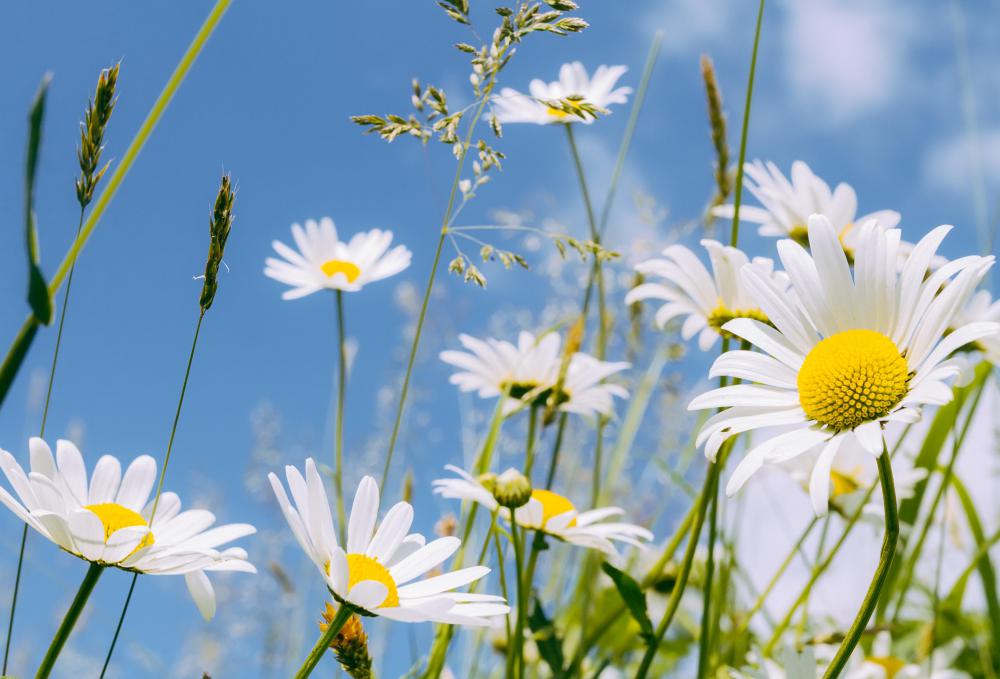At WiseGEEK, we're committed to delivering accurate, trustworthy information. Our expert-authored content is rigorously fact-checked and sourced from credible authorities. Discover how we uphold the highest standards in providing you with reliable knowledge.
What is a Shasta Daisy?
The Shasta daisy is a perennial flower which produces large white daisy-like flower heads. This plant was named as the Plant of the Year in 2003 by the Perennial Plant Association, and it has long been a favorite of gardeners all over the world. Many garden stores sell Shasta daisy seeds and seedlings, and gardeners can also cultivate the plant by dividing existing clumps of daisies in the gardens of willing friends and neighbors.
This plant was produced as a chrysanthemum cross by noted horticulturist Luther Burbank. While the Shasta daisy is technically in the Chrysanthemum genus, it is often placed in its own genus, Leucanthemum, because it lacks some of the key characteristics associated with chrysanthemums.

Shasta daisies do very well in a butterfly garden, as butterflies are attracted to the vivid flowers. They also work very well as cut flowers, standing up well even after several days. Flower arrangers who find the white color a little dull can dye the flowers by placing cut flowers in colored water and leaving them there for at least 24 hours, allowing the capillary action in the flowers to draw the color up into the blooms.
Shasta daisies produce bold, bright flowers in neat clusters, and the plants are famously hardy. They can grow in USDA zones four through 10, and most cultivars have large stalks which are strong enough to hold the blooms upright so that they do not droop with weight. Shasta daisies can be grown in a field or as a perennial border for a flower bed, and they get along well with most other plants.
Caring for Shasta daisies is relatively easy. After the first hard frost of the year, the plants should be trimmed back close to the ground, and in the spring, fertilizer and mulch should be applied. In the late spring, the Shasta daisies will start to flower, producing their signature bright blooms which show up starkly against the glossy green foliage. If they are deadheaded routinely, the plants will continue to flower into the fall before dying off. Every three to four years, clumps of Shasta daisies should be divided.
There are some considerations to think about when planting or seeding Shasta daisies. The first is that the Shasta daisy has a strong odor which some people find objectionable, so it may not be advisable for under-window plantings. The plants also prefer full sun and well-drained soil. Some good pairings for the Shasta daisy in the garden include phlox, delphiniums, catmint, irises, and yarrow, although gardeners are more than welcome to explore other planting companions.
AS FEATURED ON:
AS FEATURED ON:











Discussion Comments
Shasta daisies can take a good bit of abuse from the elements, but they definitely need plenty of space to grow. These daisies can grow as tall as four feet, so be sure that you have able room for the monster flowers.
Instead of buying a high-priced bridal veil for my niece's wedding, we made a pretty wreath from Shasta daisies. It was perfect for her Spring outdoor wedding and looked very elegant. We chose not to dye them as the white looked great with her wedding dress.
However, I can't forget to mention that there were butterflies coming at her throughout the ceremony! The guests thought it was neat, but the bride was slightly peeved by their intrusion.
Post your comments